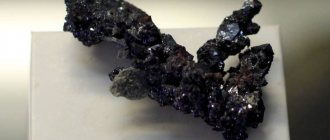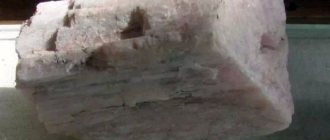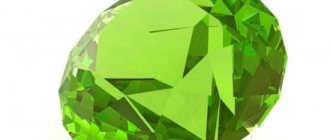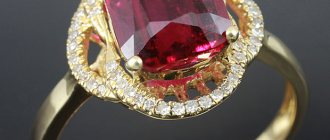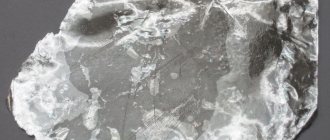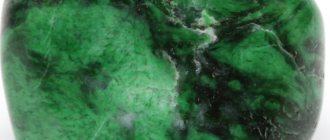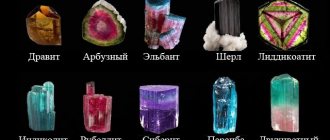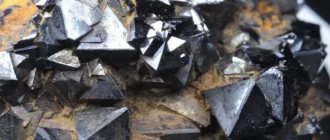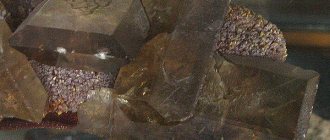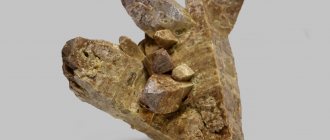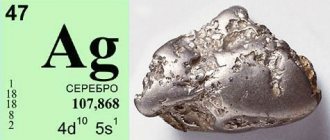| Category | Silicate minerals |
| Title in English | Nephrite |
| Formula | Ca2(Mg,Fe)5[Si4O11]2(OH)2 |
| Group | Amphiboles group |
| Color | Green, White, Gray |
| Stroke color | White |
| Shine | Bold, Glass |
| Transparency | From translucent in chips and plates 1-1.5 cm wide to opaque |
| singonia | Monoclinic |
| Hardness | 6 — 6,5 |
| Cleavage | Absent |
| Density, g/cm³ | 2,9 — 3 |
| Kink | Conchoidal, Paraffin-like |
| origin of name | In order to give the name to the mineral Jade, mineralogists took as a basis two Greek words: nephros, which translates as kidney and λίθος, which in Russian means the word “stone”. |
Jade or kidney stone is a monomineral aggregate that consists of matted fibrous tremolite-actinolite amphibole. A remarkable feature of this mineral is its high viscosity: it is very difficult to split jade. Iron, chromium and manganese, which are part of the mineral, determine its color. The color palette of the gem starts from white, includes various shades of green and ends with black. The rarest and most valuable are blue and red jade samples. Also, plain pieces are valued higher than those decorated with stripes, streaks and other patterns. Jade is widely used as an ornamental stone and a unique mineral in jewelry.
Jade deposits
Jade is a mineral widespread on our planet. Its large deposits are known in Russia, Kazakhstan, Tuva, the Urals, China, USA, Canada, Myanmar, New Zealand, Brazil, Mexico, Poland. At the same time, not even one of the oldest deposits is approaching depletion.
Care
Jade is an unpretentious semi-precious stone that does not require special care. You just need to follow the following rules:
- Periodically, it is recommended to carry out preventive cleaning; for this purpose, the stone or jewelry is placed in a soap solution, and then treated with a soft-bristled brush.
- If there is minor dirt or deposits, you can limit yourself to polishing the mineral using a soft piece of cloth.
- To decorate jewelry made from this stone, it is best to use reliable individual boxes or boxes.
History of jade
— Advertising —
People began using jade back in the Neolithic era. Then it was used in the manufacture of strong weapons and tools, and later it began to be used for jewelry. Jade was especially popular at all times in China. For example, there is a Buddha statue 6 meters high, carved from a single piece of milk jade.
Jade was also popular among other peoples due to its beauty and high strength. Tamerlane's tomb was covered with a black jade slab. The sarcophagus of Tsar Alexander III was also carved from jade.
Today jade is no less popular than in the old days as an ornamental and jewelry stone.
Price
The price of jade products depends on the type of stone and other materials (material for the frame). The cost of stone in Europe ranges from 2 to 30 dollars. However, highly artistic products can cost much more.
In the East, an emerald-colored gem is considered very valuable. It can be purchased for several tens of dollars, although the cost is influenced by different criteria (shade, purity, transparency), so it can cost much more.
View this post on Instagram
NEPHRITIS. I was shocked to realize that 80% of the stones sold in stores and at exhibitions are fakes. Jade and turquoise are the champions of the world of fakes. Jade and turquoise are very expensive and rare stones. They are difficult to obtain. They are often passed off as synthetic materials, pressed “junk” stone, or other less valuable minerals that have been chemically treated and colored. Shall we play a guessing game? Look at those green stones in the first picture. Can you accurately distinguish jade from other breeds? (Further on in the photo all minerals will be labeled)))? How to distinguish nephritis from pseudonephritis? 1. The color of jade ranges from white and gray to yellow and grass green. A non-professional in the stone business should not focus on color. Look at the shine and structure of the mineral. Jade has a FAT sheen and if you look at it (preferably with a magnifying glass), it seems to consist of fibers and inclusions, splinters. If you direct a beam at the mineral, the light inside the stone will spread as a hazy spot, highlighting the tangled fibers of actinolite and tremolite. 2. The second most important difference between jade is that this stone has very high strength. Its strength has become legendary. It is twice as strong as steel. Jade cannot be scratched with a knife or even a file. It cannot be cut, there are no dents on it, and at the same time it lends itself well to cutting. To check whether the offered product contains real jade or not, just run the sharp end of a pin over it. This will not harm real jade, but a small scratch will remain on the fake. Jade can only be cut with a diamond. 3. All natural stones have low thermal conductivity. Therefore, real jade is always cold. You can feel it by placing it on your face. Jade needs some time to heat up. 4. Finally, check the product for sound. Hit each other's beads against each other (or one of the beads against a coin); if you hear a dull sound, then this is a product made of ordinary plastic. And jade has a gentle, melodic sound, with a resonance effect. It’s not for nothing that musical instruments made from white jade plates are so popular in China. 5. Jade is never cheap. #prokamni #stone #jade #minerals #stonemood
A post shared by @ sandros.nika on Mar 2, 2021 at 1:42am PST
Physico-chemical characteristics of jade
Jade is a sodium and aluminum silicate.
Its crystals are colored in shades of green, gray, yellow, white and black, and rarely blue and red. They are translucent or opaque, without shine and cleavage, with a monoclinic system, splintered at the fracture. They do not have pleochroism. — Advertising —
The hardness of jade on the Mohs scale is 5.5-6.5. Specific gravity 2.8-3.3 g/cm3. Refractive index 1.60-1.65.
An important optical property of jade is its ability to be translucent. The light is scattered within the stone, creating the illusion of a hazy glow. This phenomenon is especially pronounced in light green and blue samples.
The durability of jade crystals is also legendary. Thanks to its fibrous structure, the stone is practically not susceptible to mechanical stress; it is one of the few rocks that are both elastic and durable.
Suitable by name and zodiac sign
Jade and zodiac signs make a good connection. It depends on what the stone looks like: color, shape, structure. Who is suitable according to their zodiac sign and how it is combined is described in detail in the following table.
| Zodiac sign | Suitable stone | Spheres of influence | ||
| Personal | Professional and creative | Interpersonal relationships | ||
| Aries | Red | Smoothes out negative personality traits and calms nerves. | Will show you the way to choose your type of activity so that it brings positive emotions and financial well-being. | It will help you treat loved ones with understanding, teach you to sympathize with others and feel them subtly. |
| Taurus | No | — | — | — |
| Twins | Blue | Sets obstacles, overcoming which people become more mature and stronger. | Creates conditions for creative development. | It will limit contact with unnecessary people who prevent Gemini from taking the right path in life. |
| Cancer | Black | It will make thinking more perfect and broaden your horizons. | It will help you change the existing way of life and give you the opportunity to try yourself in a new type of activity. | He will become an assistant in finding your person, with whom there will be complete understanding and harmony. |
| Virgo | Pink | Will give wisdom and make you more tolerant. | Will help increase material income. | Establishes harmony in relationships with your other half. |
| a lion | Red | It will pacify the character and desire for power. | Will help you find an approach to colleagues. | Will make relationships more harmonious and reduce conflict. |
| Scales | White | Helps you change your perspective on controversial issues | Will push you towards career growth and financial well-being. | Will help you find love. |
| Scorpion | White | Protects against negative energy. | It will help you shift your priorities in your professional activities. | It will help to hear the opinions of loved ones and listen to them. |
| Sagittarius | Red | Will make you more restrained, balanced and less impulsive. | Unlocks creative potential. | Will help you find love and build harmonious relationships. |
| Capricorn | No | — | — | — |
| Aquarius | Blue | Helps you get out of your comfort zone and become a more perfect person. | Improves financial situation | Helps you talk openly with loved ones |
| Fish | Black or blue | Helps you get ready and make plans. | Shows the path to career growth. | It will help you understand who in your environment has a negative impact on the implementation of Pisces’ plans. |
According to the horoscope, we combine jade with almost all signs. However, if there is a recommendation not to wear this stone, then it is better to listen to it. Otherwise, this mineral can even cause harm.
Whose name suits jade? This name must have a strong meaning. Look up your meaning, and if it includes the words “strong,” “motivated,” and “steadfast,” then this is the stone for you. Female names that go with jade:
- Anastasia;
- Victoria;
- Taisiya;
- Evgenia;
- Roxana.
Men's:
- Andrey;
- Alexei;
- Alexander;
- Matvey;
- David;
- Shamil;
- Samir.
Magical properties of jade
Jade is endowed with powerful energy properties.
The mineral makes its owner soft, fair, striving for knowledge, moderate life, courageous and honest. Thanks to the influence of the stone, happy changes occur in a person’s life, he finds ways out of dead-end situations. Jade is recommended to everyone who longs for change and rethinking of life. Since ancient times, jade has been considered a source of vitality, health and longevity. In the East it was called the “stone of victory” and a strong amulet.
Jade can bring good luck in gambling and is a reliable assistant in financial matters.
The Chinese believed that jade reacted to the behavior of its owner. Cloudiness or darkening of the stone indicated wrong actions.
The healing properties of jade
Due to its high heat capacity, jade is a warm and pleasant stone to the touch.
It is often applied to the stomach and kidney area as a compress or heating pad to relieve pain. This is why jade is called "kidney stone" and is considered a good remedy for kidney diseases. In addition, the mineral helps normalize blood pressure, improve the functioning of the lungs and heart, liver and stomach, circulatory system, and improve hearing and vision. In lithotherapy, it is used as a remedy for headaches, dizziness, atherosclerosis, stroke and eye diseases.
Special massage rollers are made from the mineral to relieve headaches, normalize blood pressure, enhance potency, as well as cosmetic massages to eliminate wrinkles and sagging skin. Jade massage stimulates blood circulation and relieves fatigue.
Nowadays, jade pillows, which were widely used in Ancient China, are also very popular.
Myths and legends: what does the moon hare pound in a mortar?
Jade has been known and popular since the very dawn of humanity. Due to its strength, this stone was used by primitive people: arrowheads, knives and other tools were made from it. Therefore, another name for jade is “axe stone.” Jade has been considered a sacred stone in many civilizations.
Jade was especially revered in Ancient China. Here it was considered a national stone; seals were made from it, as well as plaques, which were valued on a par with coins. Jade discs and plates were used in various rituals. A musical instrument resembling a xylophone was made from thin slices of jade.
In Ancient China, it was believed that the five main properties of this mineral correspond to the spiritual qualities of a person: soft shine - kindness, strength - justice, inflexibility - courage, the sound that jade makes when struck - the ability to learn and science, and the impossibility of counterfeiting this stone symbolized purity. By the way, Confucius is credited with an expression that characterizes a good person: “His morals are as pure as jade.” In general, many Chinese proverbs dedicated to the moral and spiritual qualities of a person mention jade. In Chinese culture, this stone is a symbol of perfection, of all that is most precious and beautiful. It is no coincidence that it is believed that the throne of Buddha is made of jade. The epithet “jade” is very common, and the hieroglyph that denotes this stone is an integral part of many women’s names.
Of course, jade often appears in Chinese myths and legends. One of them says that he appeared on earth as a gift from the gods to one pious emperor, who prayed tirelessly, made generous sacrifices and led a pious life. The gods had a unique idea of the reward: jade stones, quite large, simply fell from the sky for three days and three nights. Residents of the city were already preparing for the end of their lives and were hiding in their houses. But the “rain” of stones stopped, and the emperor was the first of all to decide to look outside. He was surprised to see many unknown stones on the streets of the city. But as soon as he took one of them in his hands, all the wonderful properties of jade were immediately revealed to him. Since then, this mineral is sometimes called the imperial stone.
There is another version of the myth about the origin of jade. According to her, this stone appeared from the bone marrow of the giant Pangu, from whose body the earth, water, mountains, rivers and sky arose. True, in some sources this myth is not about jade, but about jadeite. These stones are related and similar, but still different from each other, for a long time they were considered the same mineral.
In ancient China, jade was revered as a stone capable of granting immortality, and this is also reflected in myths and legends. According to legend, the goddess Siwan-Mu, who holds the secret of immortality, lives in heaven on a jade mountain and bathes in a jade lake. There is a well-known Chinese legend about a jade hare that lives on the moon. Here is also the jade palace of Great Coolness - the home of the moon goddess Chang-e. She gives the moon hare pieces of jade, which he crushes in a mortar, creating an elixir of immortality.
Among the ancient Turkic peoples, jade was considered a stone of victory and was actively used in decorating military equipment, including swords. According to legend, Genghis Khan, who greatly revered this stone, had a personal jade seal with the image of a tiger. By the way, legends connect this mineral with the name of another great commander - Alexander the Great. They say that he had a jade pendant that brought good luck in battles. But the commander lost her on the banks of the Euphrates while swimming, and since then his luck has turned away from him.
In the mythology of the indigenous population of New Zealand - the Maori - jade also occupies a very important place. The people of this tribe handed down the stone from century to century, it was considered such a rare value. Pendants were cut out of it, depicting the figures of ancestors. To find jade, it was customary for the Maori to seek the help of a “specialist”. When seekers set out to mine a stone, they always took a sorcerer with them. At the supposed location of the mineral, he entered a trance state. Afterwards he told how he communicated with spirits who told him exactly where to look for jade. By the way, due to the significant historical role in Maori culture, New Zealand jade deposits have been placed under their management since 1997.
The Aztecs and Mayans, who lived in what is now Mexico, also held jade in high esteem. They valued this durable stone much higher than soft gold, which at one time greatly surprised the Spanish conquerors. The Indians of South America placed pieces of jade in the mouths of the dead to guarantee their resurrection in the future, and also decorated the dead with jade mosaics and rings. It was also believed that jade helps communicate with spirits. In addition, various healing properties were attributed to it. One of the Aztec legends says that from jade (according to another version - jadeite), the gods create an unborn baby, who is then placed in the mother’s womb. So this stone became a women's talisman that protects against infertility.
Branches of jade application
In ancient times, jade was used as a material for tools and weapons, and later for ritual purposes.
This strong and beautiful stone is used today in jewelry and as an ornamental material for making boxes, vases, and figurines.
Its medicinal properties are also popular.
Jade colors
The color palette of jade is very diverse - from black to white due to the presence of various impurities. The most common jade is green and its shades: marsh, grassy, light green, emerald and yellow-green. Red and blue jade is very rare. The yellow-brown-green variety with a “cat’s eye” effect is also considered unique.
How to distinguish real jade from a fake
As an inexpensive stone, jade is rarely counterfeited, but imitations made from glass, clouded with pigments and fibrous structure additives, are still found.
They can be distinguished by the fact that glass is polished to a mirror shine, while jade always retains some dullness, and small defects are visible on its surface.
Where is it mined?
The traditional deposit of the mineral was previously considered to be the Chinese province of Xinjiang, however, in the 18th century, the stone began to be actively mined in Burma. Soon, jade deposits began to be found all over the world. Nephrites are mined in the Eastern Sayan, namely in the Ulakhondinskoye, Ospinskoye and Bortolskoye deposits.
For a long time, Burma was considered the only deposit. Nowadays, in addition to China and Burma, jades are mined in Germany, Italy, Central Asia, India and Switzerland, as well as on the islands of Polynesia and the Pamirs.
Prices for jade products
The cost of a processed piece of jade, depending on color and size, ranges from 2-30 dollars.
One of the most expensive is imperial jade, painted in a rich green color and highly transparent.
Cabochon-cut specimens without black inclusions of pure green color are estimated at $30-50.
Interesting facts about jade
- Until the mid-19th century, jade and jade were considered one mineral and were called jade.
- Jade is the national symbol of China, the “stone of life.” It was valued even higher than gold and silver, as the Chinese believed in its powerful magical properties. There was even a saying that “gold has a price, but jade is priceless.” According to archaeological data, the Chinese began using jade about 7000-8000 years ago. Weapons and ritual things were created from it. Chinese philosophers said that jade has five virtues: soft shine - the personification of mercy, strength - moderation and justice, translucency - symbolized honesty, purity - wisdom, changeability - courage.
National stone of China
But the real excitement around him was always observed in the Middle Kingdom. You can say this is a real Chinese stone. Here it is deified, and its beneficial properties are equated with the best qualities of a person’s character: courage, patience, compassion.
His most famous admirer is the Father of the Celestial Empire, Confucius. Jade has always represented power or proximity to it. Pillows made from it were the privilege of the imperial family, and jewelry could only be worn by residents of the Forbidden City.
